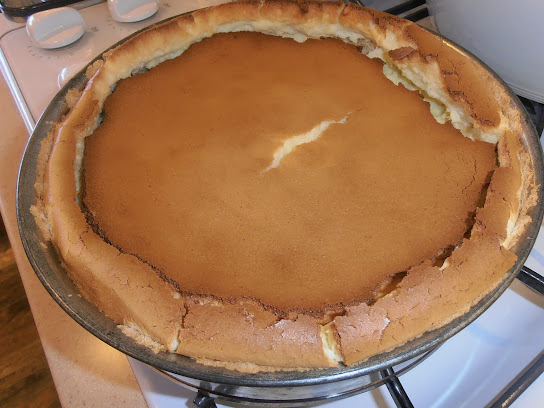What do you think of when you have a huge chunk of cream cheese that is threatening to go bad on you? Well, I thought of cheesecake. The next thought was, "Which cheesecake recipe?" You see, I have a copy of The Joy of Cheesecake by Dana Bovbjerg and Jeremy Iggers, and it gives me many, many luscious options.
 |
| ISBN 0-8120-4278-6 |
What was I in the mood for? Heavy? Light? Custardy? Marbled? Flavored with spices or fruit?
It ended being decided by how much sour cream I had in the house. With a little less than 2 cups, and not having any heavy cream, I had to limit myself to the recipes that required less than those two.
I chose the Barebottom Cheesecake on page 84:
We call this one the Barebottom Cheesecake because it works well even without a crust -- great if you are in a hurry or if you don't have any crumbs on hand. This is one of the cheesecakes we test on the customers of the Sheepshead Cafe in Iowa City. It proved to be one of the most popular ones ever served there.
With a recommendation like that, how could I resist? I chose to skip the crust and make it truly bare bottom.
Barebottom Cheesecake
1 1/2 pounds cream cheese
1 cup granulated sugar
2 tablespoons all-purpose flour
6 large eggs, separated
2 teaspoons lemon juice
1 teaspoon vanilla extract
1 cup sour cream
 |
| That is a big chunk of cream cheese! |
2. In a large mixing bowl, beat the cream cheese, sugar, and flour until light and fluffy, about 5 minutes.
3. Add the egg yolks, one at a time, beating thoroughly after each until the mixture is smooth and blended.
4. Add the lemon juice and the vanilla, then also stir in the sour cream.
5. Whip the eggs whites until they form soft peaks, then fold into the cream-cheese mixture.
6. Pour the mixture into the prepared crust or into an ungreased baking pan and bake for 1 hour, 10 minutes, until the center of the cake is firm.
7. Cool the cake in the oven for 1 hour, with the door cracked open, then cool to room temperature. Chill.
My Notes
I used my 9-inch springform pan as they recommended. Since I was not doing a crust, I left it ungreased.
I chose to use vanilla sugar instead of regular sugar because I could. I still put in the full measure of vanilla extract, though. I love vanilla!
 |
| Before beating |
The cream cheese, sugar, and flour were beaten for five minutes because I used a timer. The mixture looked light and fluffy as required.
 |
| After beating |
I had put all the yolks into one cup because I didn't read ahead in the instructions, but I used a tablespoon measure to scoop them out for the "one at a time" requirement. They made the mixture a delightful soft yellow color.
The mixture was moved into a very large mixing bowl and the metal bowl was washed to ready it for the egg whites. I think I took them to the firm peaks stage (past soft peaks) but I hoped it wouldn't be a problem.
It was a lot of mixture to fold in with the egg whites. My experience is that it is easy to miss folding in the batter near the sides and especially at the bottom, so I put in extra attention on those areas. Once it looked like there was no batter anywhere that didn't have egg white in it, I declared it folded.
The quantity of the batter was absolutely perfect for the springform pan. I was astonished at how well it fit.
 |
| A Perfect Fit! |
It went into the oven while I promised myself not to open the door at all until the 1 hour and 10 minutes mark had passed. It smelled good while it was baking!
I have to admit that this result is not what I was expecting:
 |
| Right after baking. |
And then it sank.
 |
| After cooling in the oven for one hour. |
I saw it sink more while it was cooling to room temperature.
The Verdict
My guest taster and I tried it without chilling it.

















